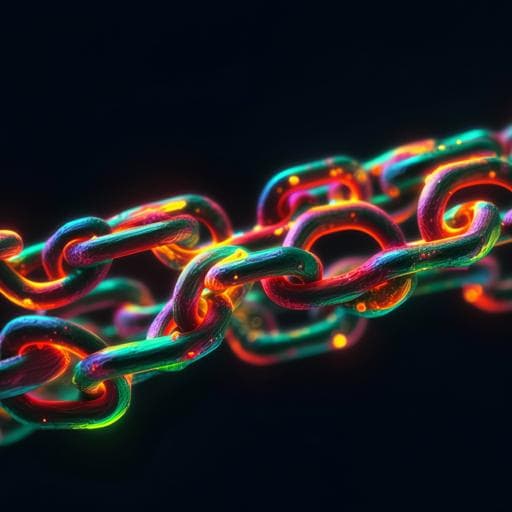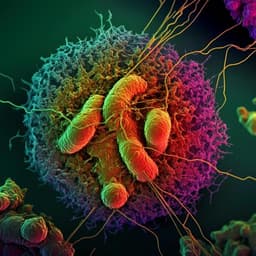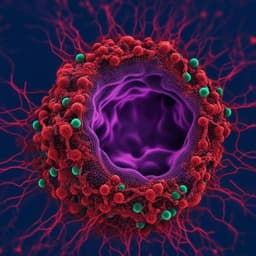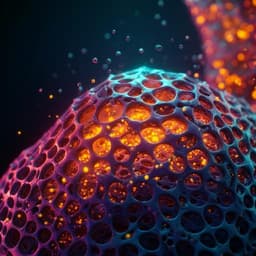
Biology
Near-atomic resolution structures of interdigitated nucleosome fibres
Z. Adhireksan, D. Sharma, et al.
Explore the groundbreaking findings on chromosome structure at the multi-nucleosomal level by researchers Zenita Adhireksan, Deepti Sharma, Phoi Leng Lee, and Curt A. Davey. Their study reveals near-atomic resolution crystal structures of nucleosome fibers that challenge the conventional understanding of chromatin architecture, uncovering a predisposition for interdigitation under specific conditions.
~3 min • Beginner • English
Introduction
The study addresses how nucleosomes assemble into higher-order chromatin structures at near-atomic resolution, a central question for understanding epigenetic regulation and genome dynamics. While individual nucleosome properties are well characterized, multi-nucleosomal architectures remain ambiguous due to their size and intrinsic dynamics and limitations of in situ imaging. Historically, a folded helical “30 nm” fibre (solenoid or two-start zigzag) was considered the canonical compaction state, yet recent in situ and biochemical studies increasingly support irregular, interdigitated fibres with zigzag characteristics and the absence of 30 nm fibres under many conditions. The authors aim to resolve how such interdigitated architectures are realized at the atomic level and what factors, especially linker DNA length and linker histone presence, dictate whether chromatin adopts interdigitated versus 30 nm configurations.
Literature Review
Prior work established nucleosome core structure (~146 bp DNA wrapped around histone octamer) and roles of linker DNA and linker histones in compaction and regulation. Classical models proposed 30 nm fibres (solenoid or two-start zigzag) forming under controlled in vitro conditions and in isolated chromatin. However, multiple in situ studies (EM, tomography, proximity mapping) indicate compact chromatin composed of irregular, interdigitated fibres lacking 30 nm structures, including globular condensates of interdigitated extended fibres at condensing Mg2+ concentrations. Some reports still observe 30 nm fibres in specialized contexts such as terminal differentiation or centromeres where nucleosome arrays are highly regular. Crystallography has provided insights into nucleosome interactions and limited higher-order assemblies but is challenged by disorder in large arrays. This work builds on cohesive-ended constructs to achieve continuous double-helix lattices enabling near-atomic structural elucidation of interdigitated fibres.
Methodology
- DNA constructs: Two non-palindromic cohesive-ended dinucleosome DNA fragments were designed: 349 (345 bp duplex + 4-nt 3′ TGCA overhangs) and 355 (351 bp duplex + 4-nt 3′ overhangs). Each includes a high-affinity Widom-based 145 bp core sequence flanked by poly-A/T tracts in linker arms and mixed-sequence segments. Three tandem repeats were cloned into pUC19 with KpnI flanks; fragments were excised by KpnI digestion and purified by FPLC (Resource Q). Full single-strand sequences are provided in the paper.
- Core histones and linker histone: Recombinant human core histones (H2A, H2B, H3, H4) expressed in E. coli with N-terminal His-tags, purified via IMAC, tags removed (thrombin), and further purified (Resource S or Mono S). Human H1.0 was cloned into pET-15b with N-terminal His-tag, expressed in BL21(DE3)/BL21(DE3)pLysS, induced with 0.5 mM IPTG, purified by HisTrap with 2 M NaCl wash to remove DNA, Heparin chromatography, His-tag removal by HRV 3C, re-purified, concentrated in 20 mM K-cacodylate pH 6.0. Mass spectrometry confirmed full-length H1.0.
- Assembly: Dinucleosomes reconstituted with recombinant histones and 349 or 355 DNA per established protocols; assemblies shown to form long fibres in solution. For H1-containing samples, linker histone was added at 1.2–1.4 H1:nucleosome molar ratio.
- Ligation assay: 2 μM dinucleosome ligated with 40 U T4 ligase in buffer (50 mM Tris pH 7.5, 10 mM MgCl2, 1 mM ATP, 10 mM DTT); time points 0.5–3 h; quenched with EDTA; analyzed by 0.8% agarose gel.
- Crystallization: Hanging-drop vapour diffusion under acidic, Ca2+-containing conditions. For 349: mix in 80–100 mM CaCl2, 50 mM KCl, 20 mM Na-acetate pH 4.5; reservoir 40–50 mM CaCl2, 25 mM KCl, 10 mM Na-acetate pH 4.5. For 355: mix in 40–80 mM CaCl2, same salts; reservoir 20–40 mM CaCl2. Final total concentration 4 mg/ml. Both with and without H1. Crystals stabilized in buffer with 10–20 mM CaCl2, 12.5 mM KCl, 10 mM Na-acetate pH 4.5, 25% MPD, 2% trehalose; MPD ramped up to 65% for improved diffraction.
- Data collection: Single-crystal X-ray diffraction at SLS beamline X06DA (Pilatus 2M-F, λ=1.0 Å, −175 °C). 349 without H1 collected on Rigaku FR-X (Pilatus 300K, λ=1.54 Å). Data processed with iMosflm, XDS, autoPROC, SCALA, AIMLESS.
- Structure solution and refinement: Molecular replacement with PHASER using NCP 601L (PDB 3UT9) and avian H5 globular domain (PDB 4QLC) as search models. Refinement with REFMAC; model building in COOT; DNA parameters via 3DNA. Graphics with PyMOL/CCP4mg. Highest-resolution models deposited as PDB IDs 6LA8, 6LA9, 6M44, 6M3V.
Key Findings
- Cohesive-ended dinucleosomes self-assemble into continuous nucleosome fibres with uninterrupted Watson-Crick double-helix continuity across the crystal lattice, forming interdigitated networks of fibres potentially spanning up to ~10^5 nucleosomes (~18 Mbp).
- Both 349 and 355 constructs form open zigzag fibres consisting of two parallel nucleosome columns that interdigitate with neighbouring fibres rather than adopting folded helical 30 nm structures.
- Resolutions and symmetry: 349 fibre structures to 3.4 Å; 355 to 3.8 Å; asymmetric unit is a dinucleosome repeat in both.
- 355 fibre architecture: Highly extended with average rise 42.5 Å per nucleosome; dinucleosome repeats stack edgewise perpendicular to fibre axis, creating a double-sided staircase. Shared linker DNA (31 bp) crosses roughly orthogonal to fibre axis; paired linker DNA (34 bp) aligns more with axis. Sparse stacking within columns, stabilized by divalent metal-assisted DNA-DNA interdigitation and histone-DNA contacts.
- 349 fibre architecture: Less extended with average rise 30.3 Å per nucleosome. Fibre axis runs between dinucleosome repeats, which are canted ~45° and stack in offset fashion within columns. Includes nucleosome face-to-face stacking with intervening DNA connectivity; paired linker segments run retrograde relative to fibre rise.
- Linker DNA dictates fibre structure: Adding 2/4 bp to shared/paired linkers in 355 vs 349 introduces twist differences of ~54° (shared) and ~88° (paired), profoundly changing nucleosome orientations and fibre geometry. Bending: 349 shared linker ~43° and paired ~19°; 355 shared ~26° and paired ~60°, with writhing facilitating interfibre groove-groove interdigitation.
- Interdigitation: Fibres run parallel and overlap in offset fashion so that one column of a fibre stacks against a column of a neighbour, yielding key-in-lock integration. Interfaces feature nucleosome face-to-edge contacts, histone-DNA interactions, and Ca2+-mediated contacts. In 355, nucleosome cores of one fibre contact linker DNA of adjacent fibres; in 349, linker DNA occupies isolated zones between columns.
- Linker histone binding: Fibre structures and packing are nearly identical with or without H1.0 (dinucleosome r.m.s.d. ~0.62 Å for 349, ~0.24 Å for 355), indicating nucleosome packing forces dominate. In 355, H1 density is disordered (mixed modes). In 349, two H1.0 globular domain modes are resolved: on-dyad (mediating intrafibre internucleosomal contacts) and non-dyad (situated in a niche bridging DNA from nucleosome cores of three separate fibres, mediating interfibre contacts). Similar DNA-binding motifs are used in both modes.
- Contact topology agrees with in vivo proximity mapping: Both fibres enrich N-to-N+2 contacts; 349 additionally enriches N-to-N+3 contacts, matching yeast and human chromatin proximity profiles without invoking folded 30 nm fibres.
- Geometric comparison: 355 zigzag resembles an untwisted, extended 2-start “30 nm” arrangement (355 over 12 nucleosomes: ~246 Å height, ~140 Å width, ~552 Å length; 2-start 30 nm model: ~272 Å height, ~272 Å width, ~287 Å length).
Discussion
The structures demonstrate that under condensing ionic conditions nucleosome chains preferentially adopt open zigzag conformations that interdigitate into dense fabrics, minimizing extreme linker DNA bending by aligning nucleosome entry/exit points. Small differences in linker DNA length (and consequent double-helix twist) strongly influence local nucleosome orientations and thus fibre architecture and interfibre packing, explaining variability in compaction states. Interdigitation is reinforced by diverse interaction types, including histone core elements (e.g., H2B C-terminal helix), DNA-DNA interdigitation mediated by divalent cations, and linker histone binding that adapts to available niches to stabilize intra- and inter-fibre contacts without dictating overall fibre configuration. These findings reconcile diverse in situ observations: prevalent interdigitated zigzag fibres in interphase and mitotic chromatin; globular condensates of interdigitated arrays at Mg2+ concentrations; and specialized cases where 30 nm fibres may occur when linker DNA length is highly regular (e.g., centromeres) or under terminal differentiation. The agreement of N-to-N+2 and N-to-N+3 contact enrichments with proximity maps supports interdigitated zigzag organization as a common mode of higher-order chromatin structure.
Conclusion
This work provides near-atomic resolution crystal structures of interdigitated chromatin fibres assembled from cohesive-ended dinucleosomes, revealing that nucleosome chains form open two-column zigzag architectures whose configuration and packing are dictated by linker DNA length and supported by adaptable linker histone binding. The approach establishes an atomic-level framework unifying many observations of chromatin compaction without requiring folded 30 nm fibres and offers models consistent with nucleosome proximity mapping in vivo. Future research should map how mixed linker lengths, histone variants and post-translational modifications, other architectural proteins, chromatin remodelers, and cationic environments modulate fibre geometry and dynamics in vivo, and determine prevalent linker histone binding modes within native chromatin contexts.
Limitations
- In vitro crystallographic systems with cohesive-ended constructs and specific ionic conditions (acidic pH ~4.5, high Ca2+) may not fully recapitulate physiological nuclear environments.
- Only two linker DNA lengths were examined; broader sampling is needed to generalize relationships between nucleosome repeat length and fibre geometry.
- Histone N-terminal tails were largely disordered and not modeled, limiting insight into tail-mediated interactions known to affect chromatin compaction.
- Linker histone density was disordered in the 355 system, preventing explicit modeling of H1 binding there.
- Crystalline packing can bias interactions and order; dynamics of fibres in solution and in vivo are not captured.
Related Publications
Explore these studies to deepen your understanding of the subject.







